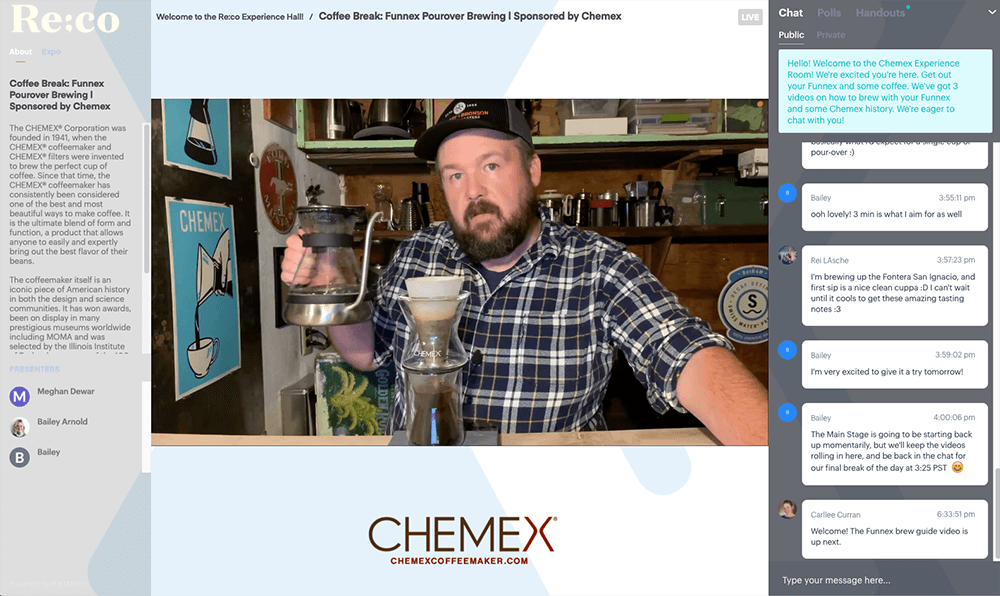
The Specialty Coffee Association’s virtual Re:co (Regarding: Coffee) Symposium featured an Experience Hall where sponsor videos showed participants how to use products, like the Chemex Funnex brewer, that came with the home experience kit they ordered. (Photos courtesy SCA)
Coffee is a staple at all face-to-face events, but at Specialty Coffee Association’s (SCA) Re:co (Regarding: Coffee) Symposium, participants’ interest in the beverage goes far beyond seeking a jolt of caffeine. And their experiences at the event go way beyond just talking about coffee.
In fact, you would be hard-pressed to find an event that involves the senses more than Re:co. “Our event has always had many multi-sensory components,” said Alex Bernson, SCA’s event marketing director. The gathering, designed for thought leadership around coffee, he said, features the newest and most exciting industry developments for a very high-end, highly focused audience, and “a big part of the value proposition of this event has always been not just the talks you see on stage.” Attendees participate in coffee-service demonstrations between sessions as well as sessions centered on sensory experiences. “The in-person aspect,” Bernson said, “is super important.”
So when Re:co, originally scheduled for April 21-23 in Portland, Oregon, had to be canceled due to COVID-19, the prospect of recreating the event online was daunting. How could multi-sensory sessions — like one in a previous year, where beekeepers organized a tasting of more than a dozen different honey samples to help participants understand how terroir (where the honey was produced) affected taste — be replicated in the virtual space? Or roasters share their new coffees? Or sponsors offer hands-on demonstrations on how to use new equipment?
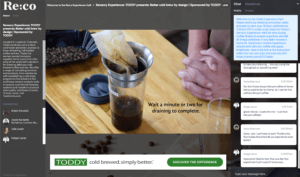
In the Toddy Experience Hall, participants were instructed when to start their 18-hour cold brew process in order to be ready for the next day’s sensory experience. Supplies for the exercise came in the home kits participants were able to purchase before the event.
In addition, there were other concerns — beyond digital — about this year’s event. “Coffee is an industry that has been devastated by COVID,” Bernson said, so deciding what to charge for the virtual event was tricky. “We were worried about the idea of a $300 price tag, even though the in-person event is usually $1,200, because it’s just such a different environment right now,” he said. SCA settled on a $295 registration fee, which included a “home experience kit” to make the online event more participatory and sensory. If they chose to participate in the digital program without receiving the boxed kit, registrants paid $260.
“We also translated our long-running Fellows scholarship program into the online space to support attendance,” Bernson said, “and community members and organizations also created spontaneous funding drives to support attendees, which we encouraged with further discounts.”
The $35 fee covered shipping, not the contents of the boxes themselves — items were provided by sponsors. SCA charged an additional $25 for international registrants, who had to bear their own customs fees, Bernson said. “We did a lot of research and you don’t want to bundle those in,” he said, “as it turns out.”
The logistics involved in assembling the boxes were complicated, Bernson said, “from getting all of the different sponsored items into a central warehouse in California, keeping in mind that coffee is a very perishable product … to packaging everything up in a nice box for a nice experience, and then shipping it to anywhere from Kansas City to Nairobi.”
In total, SCA produced 300 boxes for 450 registrants for the virtual Re:co, held July 16-17. Bernson thinks they could have sold more if they hadn’t sold out shortly before the event.
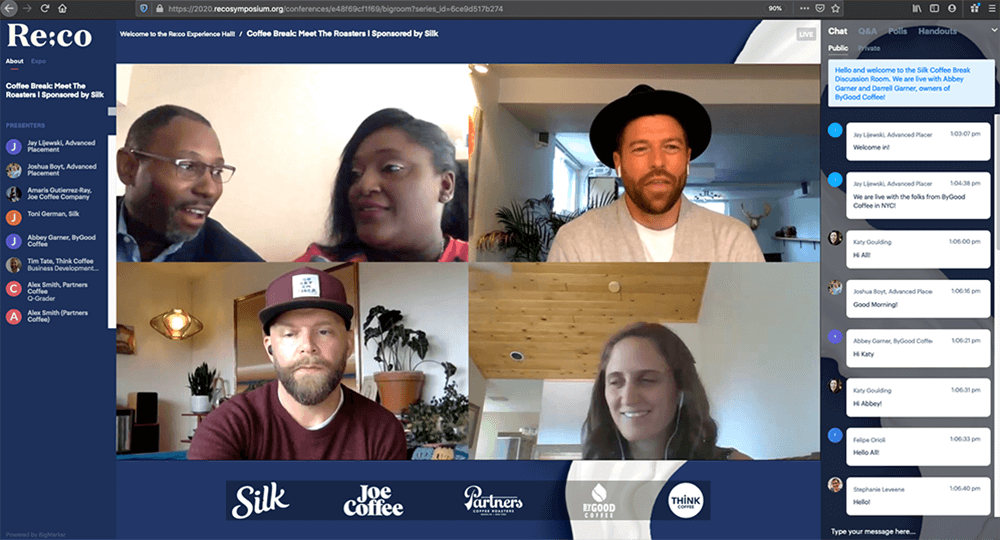
In the Silk Coffee Break Discussion Room, participants were able to speak with coffee roasters like Abbey and Darrell Garner, owners of ByGood Coffee.
Experience Hall
The program, which ran eight hours each day, included four one-hour breaks. Participants could step away from their screens during those breaks or they could go from the Main Stage to the Experience Hall for Coffee Break activities, like visiting different rooms named after their sponsors. In the Chemex Room, for example, participants could watch a video produced by Chemex on how to use its new Funnex brewer, which was part of the experience kit. Kit recipients also received coffee from four different U.S. roasters, sponsored by Silk, a plant-based alternative milk products company. Participants could meet the roaster behind the coffee that they were drinking during interviews in the Silk Room.
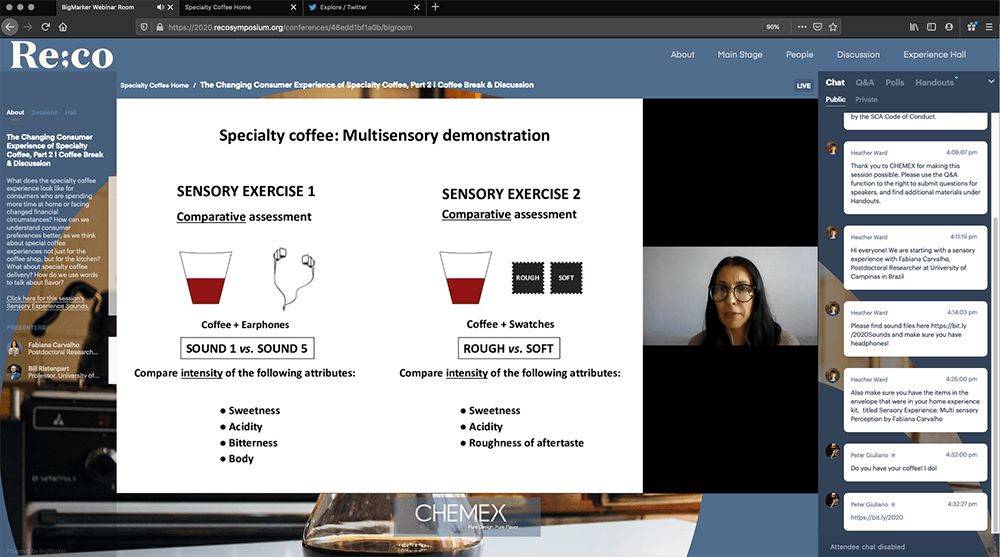
Fabiana Carvalho. (right) led participants through two sensory exercises that demonstrated how our other senses inform how we taste coffee.
Multi-Sensory Elements
Other items in the home experience kit were directly tied to sensory activities. For example, participants were led in a guided tea tasting and encouraged to type in whatever associations they made with each variety of tea they tried into a word cloud.
Another session was led by “a really amazing sensory scientist,” Bernson said, Fabiana Carvalho, a postdoctoral researcher at the University of Campinas in Brazil. Carvalho led participants through an exercise in which they compared the flavor intensity of two coffees they had received in their boxes while listening to two kinds of sounds, and in another, when touching a swatch of sandpaper vs. a silk swatch.
Those exercises went beyond demonstrating how taste is influenced by other senses to spotlight a more practical aspect of the business. The session evolved into a discussion about packaging, which “is a really relevant thing to our industry at the moment, because so much consumption is shifting from in the café to at-home or take-away, either shipped to someone or picked up,” Bernson said. “And that’s often boxed, it’s packaged in new ways. And so the sensory thing is very important.”
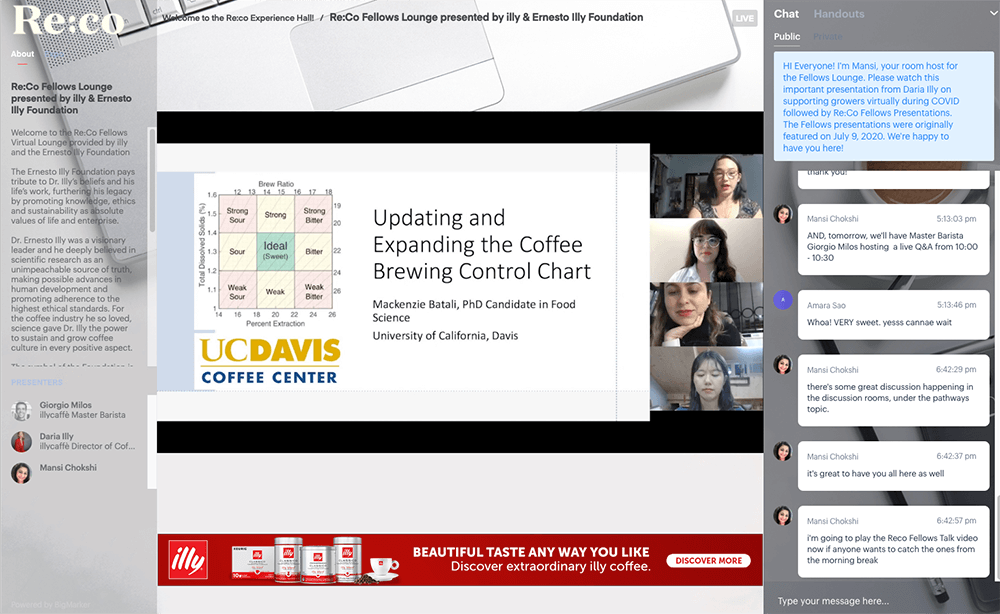
A Coffee Break room featuring recordings of SCA’s Fellows Talks gave participants a chance to meet and talk.
‘Serendipitous Interactions’
Also in the Coffee Break spaces was a room that featured looped recordings of SCA’s Fellows Talks. “It’s a scholarship program for people who are in progress on very cool things,” Bernson said. The fellows shared what they are doing in brief talks and then were available to chat with participants about it.
“That idea of everyone coming together on the Main Stage for one talk and then we send people off to the Experience Hall to browse amongst themselves, seemed to work well and helped us … have the smaller, more serendipitous interactions,” Bernson said. “So, having six different rooms, each with its own thing that you can do, and some of which had an in-person component, I think really helped there.”
Re:co also had “five different chat rooms dedicated to the five different session topics that we had for different talks throughout the two days,” Bernson said. “People could be in there during the talks if they wanted to, as a place to have a side chat about it all. It’s where we took the overflow discussion after the sessions during the break. A lot people just hung out there during the breaks. And you could also message attendees one-to-one.”
The chat rooms proved to be “really valuable for sponsors,” he said. “I witnessed — heartwarmingly, I’ll admit — multiple sponsors get sales leads directly in those chat rooms. Someone would be like, ‘This is great. Where can I get it?’ And the sponsor in the room was like, ‘Awesome. Where are you located? Let’s talk, I’m messaging you.’ I think that’s a huge value-add.” Bernson said that “especially in the era of GDPR, which is very important to us as a multinational association, it’s very hard for us to offer sponsors things like direct contacts,” so the chat rooms, sponsored coffee-break rooms, and the boxes provided those direct connections to them.
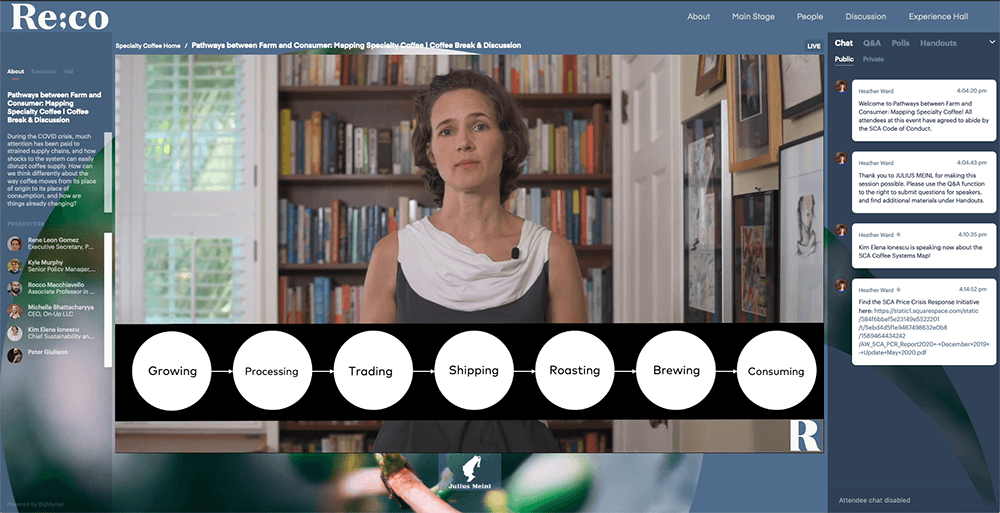
The Main Stage featured sessions on various topics as well as a Q&A channel to delve deeper into those topics.
Production Considerations
The Main Stage featured a Q&A channel for participants to submit questions to the speakers, and the other sessions included a chat feature. Fourteen out of 16 talks in the program were pre-recorded. “We pre-recorded the speakers’ talks, and then we did some editing, and a little bit of slight multi-angle work on them first. Day of, we played the pre-recorded talks and then we had the speakers dial in live for Q&A after each talk,” Bernson said. “There’s no going back once you do [pre-recorded sessions], because it takes away so much of the potential for mishap.”
SCA also did some prep work to enhance the quality of the recordings, Bernson said. “Everyone is awash in awful-looking video content right now,” he said, so “we shipped iPhone lighting rig kits to some folks, we did a tech inventory of all of our speakers across the world, and had a tech call — it was really valuable.” Bernson thinks the high-quality videos were instrumental in bringing people into the Main Stage. “We saw an average of 350 people out of the 450 registrants in each session,” he said. “It was really steady and strong.”
Bernson has this advice for other event organizers who are producing digital events: “It’s very easy to let the technical platform decide for you what you think it is you’re doing and set your limitations,” he said, but it’s more important to figure out first what’s important to your audience and then find the platform that will enable it.
“Networking is not just a feature checkbox,” he said. “We could have said let’s have 20 different little video rooms, and we could brand them and play little automated videos and stuff,” but that wouldn’t have resonated with their audience, he said. “We asked ourselves: What is it that we’re shipping to people? How does it tie into the content? How’s it tie into what they would want to do? What are they even thinking about right now?”
Bernson acknowledged that it was challenging to plan Re:co 2020, but in the end, he said, “we delivered what I am confident in saying was a fantastic, extremely sponsor-valuable and attendee-engaging experience that looked great and was polished.”
Michelle Russell is editor in chief of Convene.
